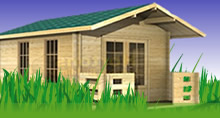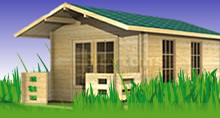We are able to provide a CAD drawing for each base if you intend to install this item yourself.
Method of construction of the Hortons raised timber base
1) 47x150mm tanalised timbers are fixed together to form the ring beam around the outer edge (the timbers may need to be cut down to suit your cabin as they are supplied in standard lengths, please check this before assembly), which is then chocked up to be level and square (just above ground level, giving under floor ventilation) to form an outer ring beam for the main cabin walls to bear on.
2) This then dictates where the corner posts are to be concreted into the ground. Once the corner holes are dug, the plastic posts can then be offered into the holes, cut off to the correct length (the posts are supplied in long lengths to give flexibility for the lengths required, we allow a nominal 400mm length per post), bolted to each of the timbers it is in contact with (lengths of threaded rod, nuts and washers are supplied with our kits) and concreted in using the quick setting postmix which is also supplied with our kits.
3) Further intermediate plastic posts are then fixed onto the outer ring beam in the same manner as the corner posts at no more than 2m spacings.
4) The position of the internal joists can then be marked around the outer ring beam timbers. Joist hangers (supplied with the kit) are then fixed according to the marking out and the internal joists fixed into the joist hangers. Joist hangers are only required where there are no posts to bolt the timbers to (joist hangers make it difficult to drill the bolt holes as you would need to drill through metal as well)
5) If the span of the internal joists is greater than 3m then intermediate plastic posts are required which are are bolted to the joists in the same manner as the outer ring beam.
Your posts should not rest on the bottom of the holes but be suspended about 100mm up from the bottom (by bolting them to the chocked up timbers). This will then make sure that the concrete is underneath the posts, giving support (we allow half a bag of postmix for each post) - there is no need to fill the holes all the way up to the top as all of the weight is downwards rather than sideways as would be expected with a fencepost where the wind adds a lot of sideways stress.
It is also possible that more materials may be required once the groundworks have started (there may be soft ground or tree roots where posts have to be moved in order to span across them or if heavy equipment is to be installed where an extra post or more concrete may be required, at extra cost, for extra support, etc.), this is impossible to allow for before this point but can be supplied very quickly to avoid delays. It is the customers responsibility to ensure that reasonable precautions have been taken if potential problems are known beforehand (ie if heavy loads are to be put onto the base especially if they are concentrated in one area, built up ground, hard ground in the summer which becomes soft ground in the winter due to rising water tables, etc), in order to alleviate any future problems (ie subsidence). It is not possible to guarantee the stability of the base unless you carry a ground survey by employing a qualified structural engineer to determine the structural calculations
.
This forms a very sturdy base onto which the cabins can be built directly, giving large time advantages over the more traditional concrete bases.
It is also possible to use these bases to level up an existing base by resting the plastic posts on top of what is already there, however we are unable to guarantee the long term stability of the base as we won't be sure of the integrity of what the posts are resting on top of (paving slabs or tarmac may not be laid on a proper sub-base for example). Hortons will not be liable for any subsequent movement which may affect the building on top of the base (gaps in logs, windows/doors not working properly etc).
If the building is greater than 30 sq m internal floor area, then building regulations will apply. We are able to upgrade the raised timber base to comply with building regulations at extra cost - this cost can not be determined until calculations have been made by your structural engineer and also inspections have been made by a local council building control officer once the work has commenced, who will determine the depth of holes required for the posts which is subject to site/soil conditions. Please note that in these circumstances we do not quote for or supply the concrete (as this can vary and will depend on site conditions and site inspections by your local building control department).





